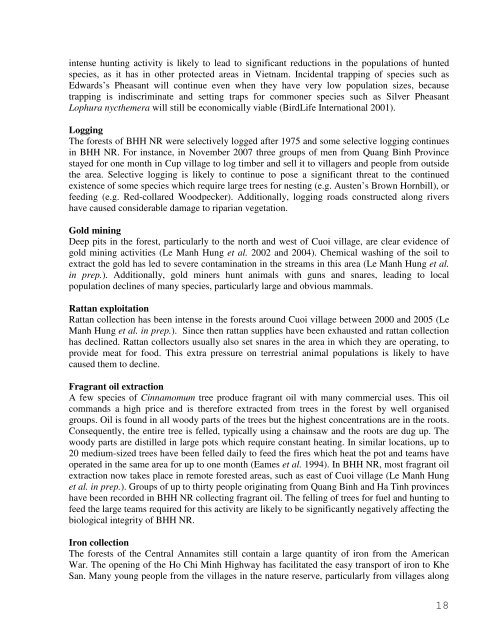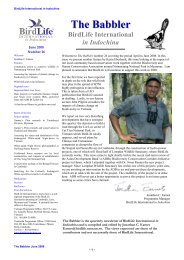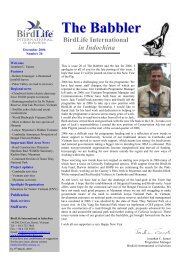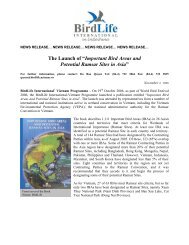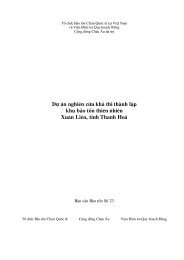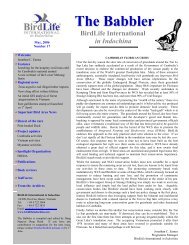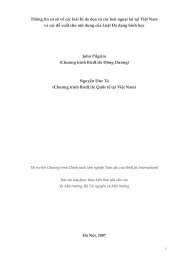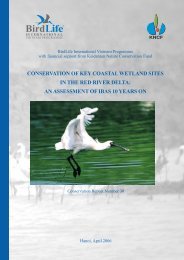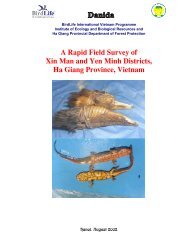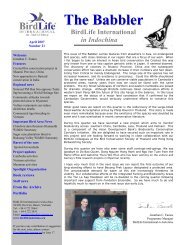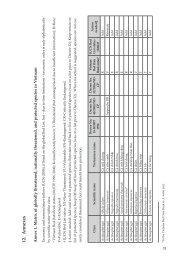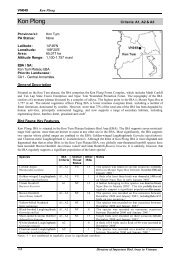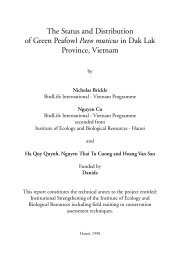The Biodiversity of Bac Huong Hoa Nature Reserve - Birdlife ...
The Biodiversity of Bac Huong Hoa Nature Reserve - Birdlife ...
The Biodiversity of Bac Huong Hoa Nature Reserve - Birdlife ...
Create successful ePaper yourself
Turn your PDF publications into a flip-book with our unique Google optimized e-Paper software.
intense hunting activity is likely to lead to significant reductions in the populations <strong>of</strong> hunted<br />
species, as it has in other protected areas in Vietnam. Incidental trapping <strong>of</strong> species such as<br />
Edwards’s Pheasant will continue even when they have very low population sizes, because<br />
trapping is indiscriminate and setting traps for commoner species such as Silver Pheasant<br />
Lophura nycthemera will still be economically viable (BirdLife International 2001).<br />
Logging<br />
<strong>The</strong> forests <strong>of</strong> BHH NR were selectively logged after 1975 and some selective logging continues<br />
in BHH NR. For instance, in November 2007 three groups <strong>of</strong> men from Quang Binh Province<br />
stayed for one month in Cup village to log timber and sell it to villagers and people from outside<br />
the area. Selective logging is likely to continue to pose a significant threat to the continued<br />
existence <strong>of</strong> some species which require large trees for nesting (e.g. Austen’s Brown Hornbill), or<br />
feeding (e.g. Red-collared Woodpecker). Additionally, logging roads constructed along rivers<br />
have caused considerable damage to riparian vegetation.<br />
Gold mining<br />
Deep pits in the forest, particularly to the north and west <strong>of</strong> Cuoi village, are clear evidence <strong>of</strong><br />
gold mining activities (Le Manh Hung et al. 2002 and 2004). Chemical washing <strong>of</strong> the soil to<br />
extract the gold has led to severe contamination in the streams in this area (Le Manh Hung et al.<br />
in prep.). Additionally, gold miners hunt animals with guns and snares, leading to local<br />
population declines <strong>of</strong> many species, particularly large and obvious mammals.<br />
Rattan exploitation<br />
Rattan collection has been intense in the forests around Cuoi village between 2000 and 2005 (Le<br />
Manh Hung et al. in prep.). Since then rattan supplies have been exhausted and rattan collection<br />
has declined. Rattan collectors usually also set snares in the area in which they are operating, to<br />
provide meat for food. This extra pressure on terrestrial animal populations is likely to have<br />
caused them to decline.<br />
Fragrant oil extraction<br />
A few species <strong>of</strong> Cinnamomum tree produce fragrant oil with many commercial uses. This oil<br />
commands a high price and is therefore extracted from trees in the forest by well organised<br />
groups. Oil is found in all woody parts <strong>of</strong> the trees but the highest concentrations are in the roots.<br />
Consequently, the entire tree is felled, typically using a chainsaw and the roots are dug up. <strong>The</strong><br />
woody parts are distilled in large pots which require constant heating. In similar locations, up to<br />
20 medium-sized trees have been felled daily to feed the fires which heat the pot and teams have<br />
operated in the same area for up to one month (Eames et al. 1994). In BHH NR, most fragrant oil<br />
extraction now takes place in remote forested areas, such as east <strong>of</strong> Cuoi village (Le Manh Hung<br />
et al. in prep.). Groups <strong>of</strong> up to thirty people originating from Quang Binh and Ha Tinh provinces<br />
have been recorded in BHH NR collecting fragrant oil. <strong>The</strong> felling <strong>of</strong> trees for fuel and hunting to<br />
feed the large teams required for this activity are likely to be significantly negatively affecting the<br />
biological integrity <strong>of</strong> BHH NR.<br />
Iron collection<br />
<strong>The</strong> forests <strong>of</strong> the Central Annamites still contain a large quantity <strong>of</strong> iron from the American<br />
War. <strong>The</strong> opening <strong>of</strong> the Ho Chi Minh Highway has facilitated the easy transport <strong>of</strong> iron to Khe<br />
San. Many young people from the villages in the nature reserve, particularly from villages along<br />
18


